
I found these beautiful metallic jewel bugs (Scutifora pedicellata) while out walking. A nice find on a day when there was a lot to see.
I respectfully acknowledge the Yallock-Bulluk people of the Bunurong nation who are the traditional custodians of the Country in which I walked and am writing about here. I pay my respects to their elders past and present, knowing the stories of the Aboriginal people will always be written in this landscape.
I’ve been exploring the shore ecologies of the Bass Coast in Australia, with their vigorous interaction of elements, flora, and fauna. Walking just a few miles along the beach between Harmers Haven and Cutlers Beach was a saturation experience of beach life and geology. There wasn’t another person to be seen, and only the wet sand of the foreshore sported footprints that betrayed the recent presence of a single large dog and its owner. Surf waves broke on a submerged offshore reef, before reaching the shoreline. Along the beach in the opposite direction, wooden and iron remnants of the wreck of a three masted ship, “The Artisan,” which ran aground during a storm in 1901, can still be seen.
This is a place of different, overlapping environments and there’s an urgency to take photos that capture them all, so this post is something of a photo essay. I haven’t attempted to include everything but hope this gives readers a sense of a coastline that is vibrantly alive and threatened by climate change. As a visitor, I’m aware that my own presence is ecologically intrusive and that there’s a need to move with a light footprint. Also, I’m learning about this environment, so welcome comments from readers who know more about it.

This post is about a walk I took along the Harmers Haven to Cutlers Beach section of the Yallock-Bulluk National Park and Bunurung Marine National Park. These parks, which aim to provide protection for land and marine ecologies, are named after the indigenous people for whom the area is home. Parks Victoria explains that the naming of Yallock-Bulluk honours the Yallock-Bulluk Clan of the Bunurong Nation: Yallock refers to swamp land and Bulluk means river or creek, which describes natural environments from Tooradin to the Tarwin River. The name was recommended by the Bunurong Land Council Aboriginal Corporation, who are the Registered Aboriginal Party for this Country and the Traditional Owner group legally recognised under the Aboriginal Heritage Act (2006).
My walk began along a narrow footpath through a stretch of coastal swamp scrub that gives way to a coastal dune scrub mosaic. Superb fairywrens, the males unmissable with their electric blue and black plumage, and other small birds that I couldn’t easily identify, love this dense habitat. For more information on superb and other fairywrens, see the Fairywren Project. A Nankeen kestrel watched us from a post demarcating the other side of the scrub from farmland. This dense swathe of coast tea tree (Leptospermum laevigatum) and swamp paperbark (Melaleuca ericifolia) is also home to endangered southern brown bandicoots. A sign informs walkers that predation by foxes and cats is threatening the existence of these small-rabbit-sized marsupials. Classed as endangered and dependent on a habitat of low, dense vegetation, bandicoots are diggers that play an important part in ecological health and sustainability. Together here with echidnas, wombats (I’ve seen several of these latter two, but never a bandicoot) and earthworms, their role in soil perturbation has led to their being called eco-engineers, with one bandicoot able to turn over 3.9 tonnes of earth per year (see Victoria Energy, Environment and Climate Action Conservation program “Protecting the Southern Brown Bandicoot“). This made me think more about an article I’m writing on attitudes towards earthworms in the early nineteenth century. Charles Darwin pioneered recognition of their role in soil health, lecturing on and writing about them in the 1830s and again in the later nineteenth century.

The path scrub path becomes less dense before opening onto dunes and a backshore beach habitat, overlooking the Bass Strait that separates mainland Australia and Tasmania. Native coastal grasses and plants, including tough hairy spinifex, coast everlasting (Ozathamnus turbinatus), and pigface (Carpobrotus glaucescens) thrive in the salty winds, maintaining the stability of this windblown environment. Other grasses and sand-loving plants are too many to list here, and spinifex dominates, so if you’re interested I suggest sites including those provided by the Bass Coast Shire Council and, for threatened species and communities, the Victoria Government’s list according to the Flora and Fauna Guarantee Act 1988.


Where the dunes meet the beach, critically endangered Hooded plovers nest on the open sand. With an estimated 750 individuals remaining in Victoria, up from 400 between 1990 and 2000, and just 1664 in Australia and New Zealand (figures from 2022. See the Great Ocean Road Coast and Parks Authority page), the “hoodie” is vulnerable to habitat loss, predation, and to accidental disturbance (such as their nests being trodden on), which are likely eventually to result in its extinction. Yet a pair were not difficult to spot and didn’t seem all that much disturbed by our passing by them at a moderate distance.

I wonder if the two species of gull that I see are a problem for hoodies? I was able to take photos of a silver gull on the backshore sand and a Pacific gull at the water’s edge running into flight with a large mollusc in its oversized yellow, red-tipped beak.


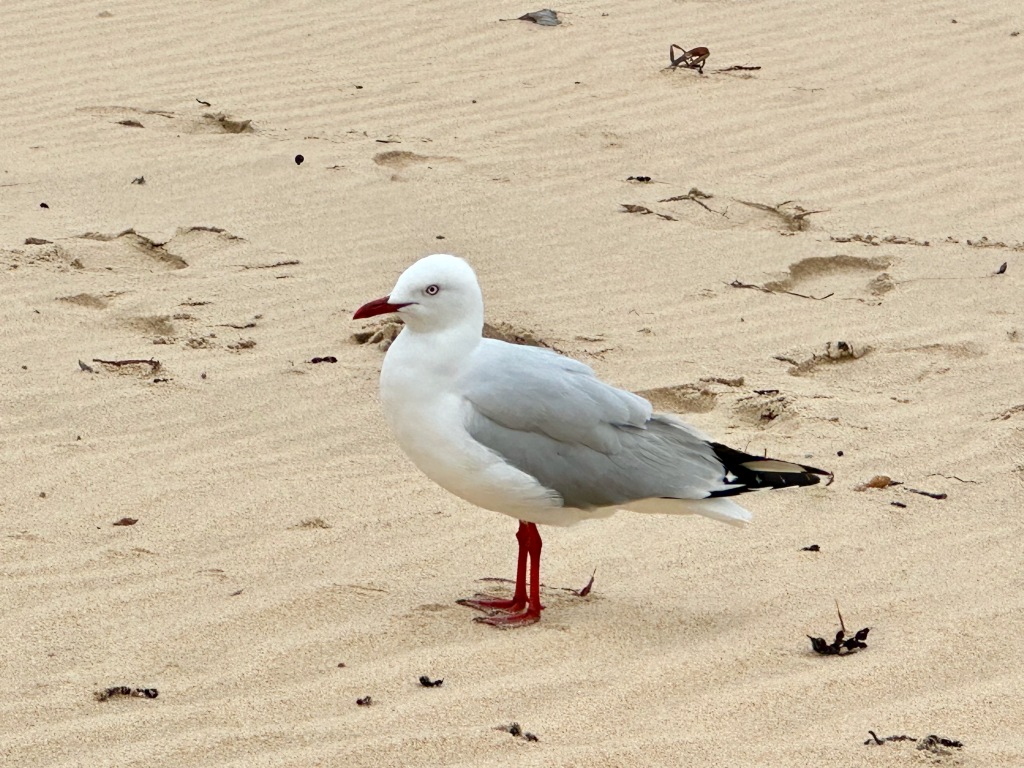
Gulls have a bad press, but these really are beautiful. Other birds seen on the walk include a large black oystercatcher fishing in rock pools, a lone white-faced heron likewise looking for food, and several black and pied cormorants hunched in spray on rocks near the shoreline, looking like shipwrecked mariners. It’s easy to understand how cormorants have acquired gothic significance in folklore, their shiny plumage and posture suggesting oilskins and sou’westers. I’m reminded of the Scottish story of the disappeared Flannan Isle Lighthouse keepers in the Outer Hebrides in 1900, adapted by Peter Maxwell Davies in his 1979 thriller chamber opera The Lighthouse and more recently in the 2019 film The Vanishing. A tender (supplies) ship arriving at the David Stevenson-designed lighthouse found the three keepers gone without trace, while three large cormorants watched the search from a rock. Towards the end of my walk, a soaring, black-shouldered Kite hunting over the swamp scrub brought to mind a different literary episode — the encounter with an airborne merlin in Henry David Thoreau’s Walden:
It was the most ethereal flight I had ever witnessed. It did not simply flutter like a butterfly, nor soar like the larger hawks, but it sported with proud reliance in the fields of air. . . . It appeared to have no companion in the universe, —sporting there alone, —and to need none but the morning and the ether with which it played. It was not lonely but made all the earth lonely beneath it.
The tide was ebbing throughout my walk, with rock pools revealing wild gardens of algae, corallines, sea anemones and molluscs. Common limpets, barnacles and tightly packed colonies of tiny mussels covered the rocks. Seaweed and other algae in rock pools play a crucial role in nutrient cycling as well as providing a habitat for small marine organisms. The common species here include Golden kelp (Ecklonia radiata), crayweed (Phyllospora comosa), red algae or seaweeds; in particular Plocamium angustum and dilatum and Phacelocarpus peperocarpos, and the gorgeously named Neptune’s necklace (Hormosira banksia). There’s a lot of red and some yellow coralline growing on the rocks, too. Corallines are among the least obvious algae living in this vivid environment because of their low-level growth, yet they are as compellingly interesting as they are integral to the ecology and food chain. While writing a recent article on historical ecologies of the Bass Rock – 17000 kilometres as the crow flies from this beach, off the Lothian Coast of Scotland – I was captivated by attention to them and to seaweed algae that thrive in the extreme ecosystem of the intertidal zone. Natural historian, Regius Professor of Natural Science, Minister in the Church of Scotland, and a founder of the Royal Society of Edinburgh, John Walker – an important contributor to the Scottish Enlightenment – wrote in 1808:
Upon the recess of the tide, we found growing on the rocks of the Basse, a very beautiful species of fucus, which we never had formerly observed. . . . At a very low ebb, I found above the surface of the water, growing three or four species of corallines. . . some of them were above three hours out of the water.
Walker regretted that he didn’t have the equipment – presumably a microscope – that would have enabled him to study the corallines, but he commended the Bass to others:
To those, however, who wish for such an opportunity, this may serve as a direction to the most favourable place that can be desired, for making observation upon these extraordinary productions.
Walker, as above.
See also:
1. “A Coastal Knowledge Ecology and an Aesthetics of Data: Environmental Science, J. M. W. Turner, and the Bass Rock,” Romanticism on the Net, 79, Susan Oliver (publication due Dec 2023)
2. “Scotland’s Coastal Romanticisms,” (forthcoming December 2023) and “‘Better Lore’ of the Romantic Coast: Maritime Ecologies and Cultural Infrastructure from England, Scotland, and Beyond“, European Romantic Review 34:3 (2023), pp. 303-315. Sam Baker, Alex Dick, Eric Gidal, Gerard McKeever and. Susan Oliver.


Molluscs in addition to those I’ve already mentioned include small black nerites (Nerita atramentosa) and larger common warreners (Turbo undulata)– both grazing organisms – blue and (I think other) periwinkles, striped-mouth conniwinks (Bembicium nano) – also grazers – and tiny false limpets (Siphonariidae) that, unlike true limpets that have gills, breathe air and can only live in the intertidal zone. I saw a chiton, sometimes called by its common name “sea mouse,” and named after the garment worn by the Greek goddess Aphrodite, nestled in a rock crevice, and some deep red Waratah anemones on the sides of pools, their tentacles retracted. It’s good to see the black nerites on the rocks, as they are a sentinel species for monitoring changes in ocean acidification that weakens the calcium carbonate content of their shells, making them more vulnerable to disease and predation, as well as impacting reproduction rates. There were quite a few here. In my photo (above) of a pair of hooded plovers, you can see several at the waterline. A single large whelk attached to another rock was the only live example that I saw of that predatory species, although there were empty shells left by the tide.


I’ll write another post about the sedimentary rocks along the shoreline between Harmers Haven and Cutlers Beach. Grey, flat, striated and showing sections of fossilized wood (this was a coal mining area), they reveal the deep time history of the area. Coal is visible in the rocks and washed ashore. Wonthaggi has been a coal mining town and Harmers Haven grew as a hamlet where mining and other working families settled by the ocean.
I didn’t see any rock pool fish on this walk, but while snorkelling in the following days saw several species that are part of this fragile biotic community, including strikingly patterned zebra fish, the lovely and badly named common weedfish (Heteroclinus perspicillatus) that seemed not too troubled by my presence and swam alongside me, mullet, and what I think were rough bullseye (Pempheris klunzingeri). They’re also for a new post.
1.5 – Stay Alive . . . A new film that brings together climate science and music from the Caribbean. I’m grateful to Lisa Paravisini Gebert and her Repeating Islands blog for bringing it to my attention.
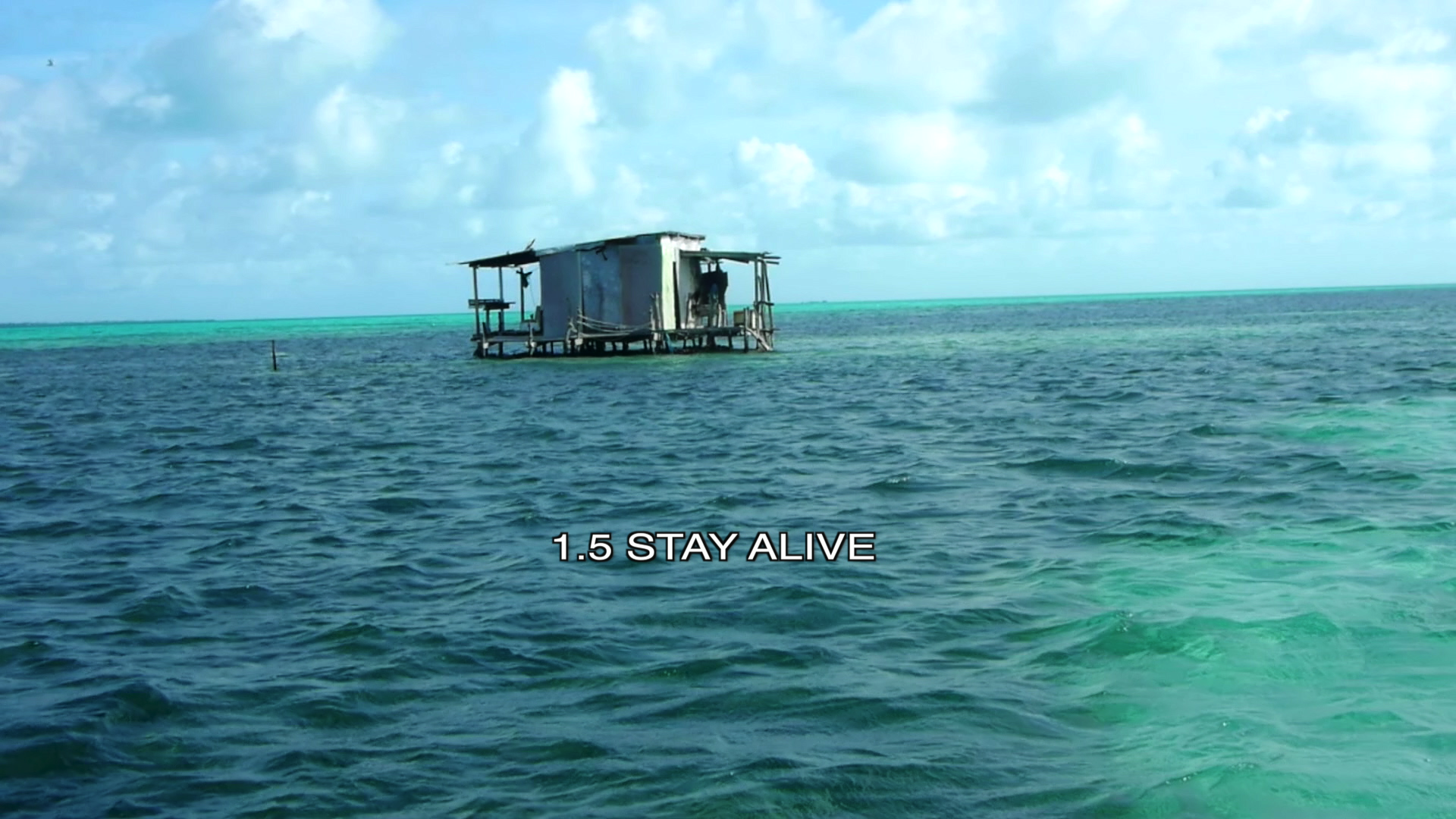
View original post 267 more words
Thinking of our academic colleagues in Puerto Rico in the wake of Hurricane Maria. 💚
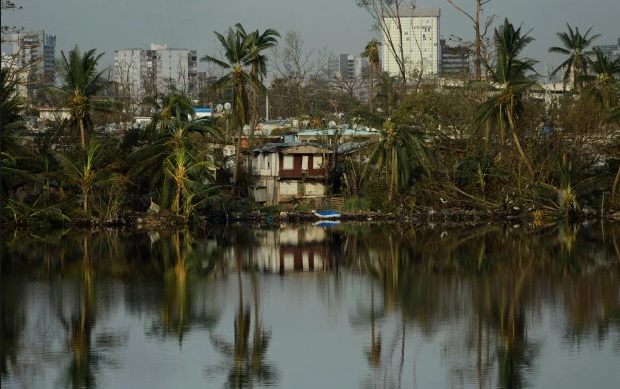
A report by Samuel Hoisington for the Chronicle of Higher Education.
The University of Puerto Rico’s 11 campuses and central office are closed in the wake of the devastation wrought by Hurricane Maria.
“The whole island is without power right now, and the destruction has been catastrophic,” Joseph Martinez Huarneck, the university’s director of communications, told The Chronicle in an email on Thursday. “The communications infrastructure has practically collapsed. Cellphone and internet service are unstable. TV and radio stations, except three or four, are unable to broadcast.” He said it was unclear when the university would be able to reopen. “It will all depend on when power is restored,” he said.
Additional emails to Mr. Huarneck and other staff members weren’t immediately returned. A message on the university’s website says: “Due to the effects of Hurricane Maria in Puerto Rico, our services and communications are limited. We will provide…
View original post 199 more words
Snow and frozen waterfall in the Colorado Rocky Mountains above Estes Park. Photo:©Susan Oliver
I have to share a video (see below for YouTube link): please watch billy barr’s deeply moving short story of snow. It’s a Gothic tale of a man living in a cabin in the woods, in winter – all those clichés, but for real and with a difference. I take my hat off to this man and self-styled snow guardian (who you’ll find has his own collection of headwear).
If you follow this blog you might know that one of my favourite ecopoems is Robinson Jeffers’ “All the Little Hoof-Prints” (in Such Counsels You Gave to Me, 1935-38). billy barr – lower case is his chosen orthography – in some ways, but only some, reminds me of the man living in the woods near Pigeon Gap. Like Jeffers’ fictional solitary, he cares quietly and with will. Rocky Mountain snow is the dust at his feet. Take two people, one living in a poem set in California and the other in Colorado, for whom land ethics are plain and simple common sense. If the parallels between them end there, so be it. I’m also reminded of the river keeper in Patagonia film’s DamNation, who at the time the film was made had spent 13 years quietly monitoring endangered steelhead trout in the Umpqua River.
These are stories for our time, on a small scale but with a big message. Thanks to billy barr for caring and sharing.
The film is by Day’s Edge Productions, a company that specializes in “telling stories about science, nature, conservation and adventure.” I also note that the University of Wyoming, who so generously made me Honorary Fellow in Literary Studies in their Department of English, was involved in the production. Thanks to the people at Day’s Edge, UW, and everyone else who made these 5 minutes of powerful viewing.
“Within a few weeks these murals will be forever gone, but for those who find them, I hope they ignite a sense of urgency.”
(Sean Yoro, A’o ‘Ana project website 18.01.17)
Reading Georgia McCafferty’s article on artist Sean Yoro’s A’o ‘Ana (The Warning) ice mural series, and finding out more about his work, I felt compelled to share: http://edition.cnn.com/2016/11/09/arts/sean-yoro-glacier-art/index.html For further images from this stunning and moving series predicated upon the precariousness of ice, and for the artist’s comments on the project, see Jacopo Prisco’s photo essay “These haunting iceberg murals only survived for a week before they melted” and Sean Yoro’s website Hula. For copyright reasons, I’m not including any of the images here.
More on the temporality of ice:
If you’re a regular reader, you’ll know that professionally I’m a literary critic and university teacher working in British and North American nineteenth-century writing. Attention to the visual and aural agency of ice – including melting ice – has a long history and certainly isn’t new to the anthropocene. Many writers and artists, including several from the early nineteenth century, have explored that agency and its affective properties. I mentioned some period responses to sound in my previous post Ice Thoughts 2, along with the early 21st century space-sound interactive, collaborative music project by NASA, Terry Riley, and the Kronos Quartet. Here’s an update on the theme of ice music, in an article (and by reference, a book) by Stefan Helmreich. “Melt,” part of “Theorizing the Contemporary,” in the open-access refereed journal Cultural Anthropology (January 21, 2016), identifies the sound of thawing ice as a sound very much of the anthropocene, with the deep time materiality of the earth’s atmosphere at once made audible as it is lost. In turn, Stefan Helmreich takes us back to the importance of art, since at the heart of his essay is Wendy Jacob’s 2011 award-winning installation Ice Floe for Boston’s Museum of Fine Arts. A strongly recommended read with an added “listen.”

Greenland Sea, March 2016. My photo. ©Susan Oliver
Sharing this article, “Amid higher global temperatures, sea ice at record lows at poles,” by Brandon Miller, CNN meteorologist (19 November 2016)
http://edition.cnn.com/2016/11/18/world/sea-ice-arctic-antarctic-lows/index.html

Like the white ghost of a glacier the mists advance, riding over phalanxes of tamarack, sliding across bog meadows heavy with dew. A single silence hangs from horizon to horizon.
Aldo Leopold, “A Marshland Elegy,” from A Sand County Almanac: With Other Essays . . . (1949).
Travelling to Laramie for a September researching books and documents about Scottish rivers in The University of Wyoming’s Toppan Rare Books Library, I was privileged to see Greenland again from the air. A similar journey in mid March led to my earlier photo-essay, Ice Thoughts. The experience was again compelling, with clear skies giving breathtaking views of the Arctic ice sheet. I gazed at the spectacle. Ice, glaciers, rock and water. The polar ice caps and glaciers in particular capture our imaginations with an appeal that increases in power as its physical strength becomes more precarious. The great glaciers slide down to the Atlantic Ocean, calving icebergs into water that is a vivid azure blue only because it reflects the sky. The ocean is mysterious, not least because it returns images of something else. Its surface is like a book and the font of the Arctic is icebergs. The metaphor underpinning the glaciological term “calving” is increasingly unsettling, for what we’re seeing doesn’t suggest new life. Greenland’s glaciers are old and we know they aren’t regenerating. The process of calving has come to have little to do with new birth, and as the glaciers and sea ice thin (they used to thicken) the irony implicit in a word draws attention to a sickness: are these icebergs a monstrous progeny? Whatever, the sight speaks of grandeur and magnificence.
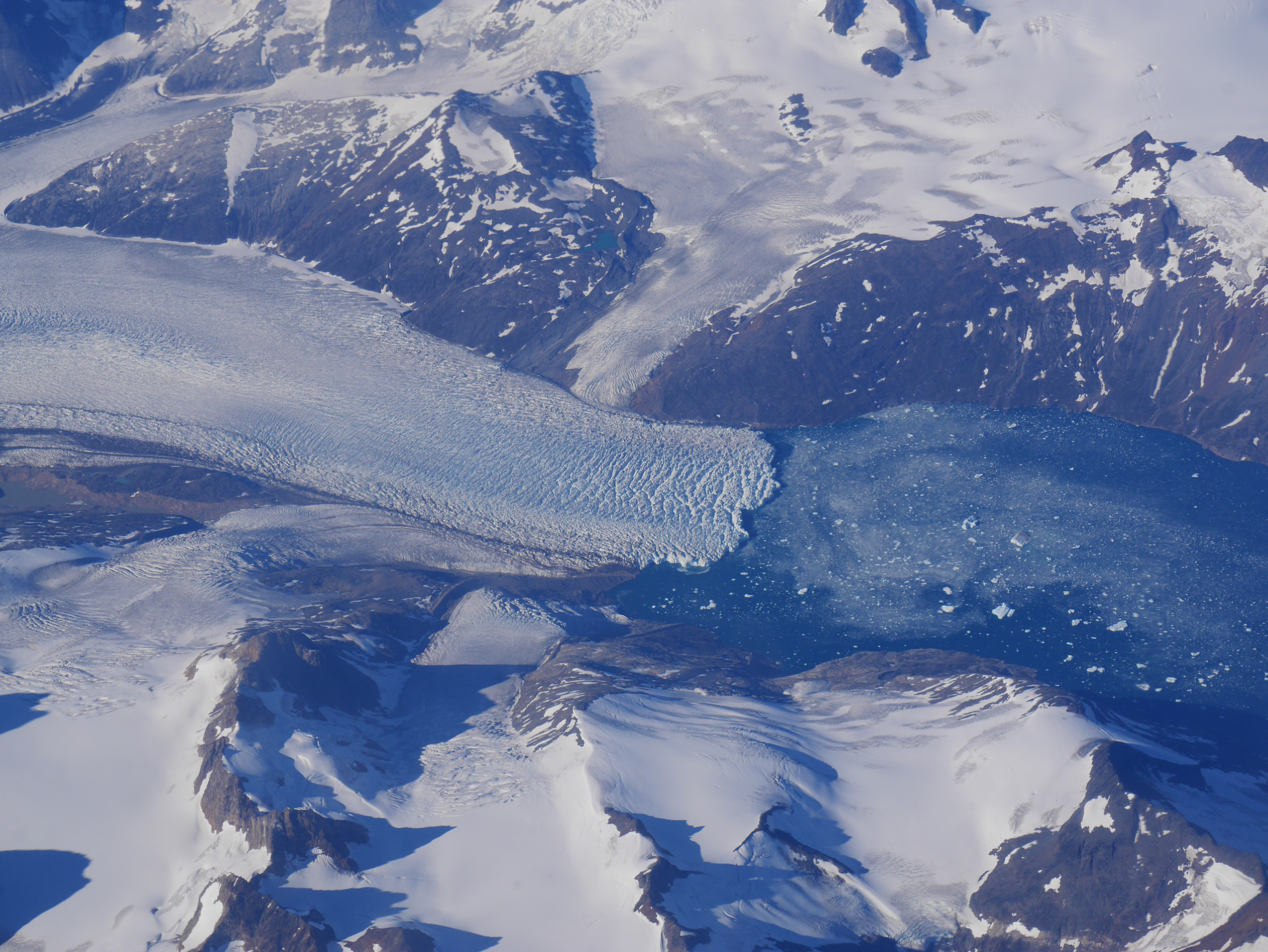
I was travelling on the gas-guzzling giant of an airliner that is a Boeing 747. If icebergs inscribe oceans to tell a tale of our warming planet, contrails are a script of the skies. Saying that the plane would fly regardless of whether I was on board isn’t adequate. But the aim here is to take up a topic that I wrote about earlier this year, with comparisons and new thoughts about ice. As I took the photos I’ve used here, a friend was somewhere below on an expedition ski-ing across Greenland. I look forward to reading her account of a range of cultural as well as environmental issues – I’ll post details when that work is available.
NASA’s Operation IceBridge mission, which has been investigating changes in the Arctic and Antarctic ice sheets since 2009, has just made public its latest findings. IceBridge‘s deep science study of melt and ice thickness in Greenland’s glaciers and ice sheet includes a comparison of aerial photographs taken from March through to late August and early September this year. Those flights, which I didn’t know of when I began working on this piece, overlapped with my own journeys, adding a scientific and artistic depth to ice writing that my two posts can’t begin sufficiently to acknowledge – I’ve provided links that I hope readers will follow. A NASA news post from 19th August begins “This year’s melt season in the Arctic Ocean and surrounding seas started with a bang, with a record low maximum extent in March.” As I write, their Image of the Day (taken on 16th September) is titled “IceBridge Observes Effects of Summer Melt on Greenland Ice Sheet.” Another post includes a map of ice melt under Greenland’s glaciers. The mission extends matters of environmental justice beyond their implications for humans, addressing species loss in an article about the impact of diminishing ice floes on polar bears: Kristin Laidre from the University of Washington’s Polar Science Centre, points out that sea ice is polar bears’ “platform for life,” since they can’t out swim the seals on which they feed. The World Wildlife Fund estimates there are currently around 22000-31000 polar bears living in 19 distinct subcultures around the Arctic cryosphere. While the population increased after hunting was controlled in the late twentieth century, predictions are for a 30% reduction in numbers by 2050 because of ice melt. Some studies estimate the East Greenland population to be around 2000 bears. The Atlantic, National Geographic and the International Business Times, along with some other newspapers and magazines, have just published articles about the Antarctic mission of Project IceBridge with some stunning photographs by Getty Images photojournalist Mario Tama who flew on the DC-8 used for the survey. Ice is news.
What place might the arts beyond visual and written works have in mediating ice science? I wonder if something like NASA’s 2001 -2002 Sun Rings collaboration with the Kronos String Quartet and composer Terry Riley might be possible, further bringing together science and music? Sun Rings, which I remember hearing at theBarbican Centre in March 2003, worked with images and sounds from NASA space archives – similar sounds are still whistling, howling, humming and crackling though the frigid cold of space. As astrophysicist Marie Bullock wrote in her program notes, “Certain sounds from the original Voyager recordings surface throughout the performance” while “the visuals for the final movement of Sun Rings were inspired by The Golden Record, an information package carried into space by the Voyager spacecrafts, which includes photographs of everyday scenes from around the world—as it was in 1977.” Terry Riley and the quartet members responded musically to those sounds and images. In 1990 the Voyager 1 space probe passed icy Pluto, where the surface temperature ranges from around -240 to -218 Celsius. It is now well into interstellar space, more than 20,559,216,000 km from earth (distance at time of this post from NASA’s Voyager Mission website). We know that the earth’s atmosphere is warming and its ice melting, but how cold is space beyond the influence of the Sun? Astrophysicists point out why it’s difficult to measure the temperature of interstellar space, but say that the average is probably around 2.725 – 3 Kelvin, or approximately -270 Celsius, while dust and gas clouds might reach 10 to 20 Kelvin, or -253 to -263 Celsius. Roughly 2.725 Kelvin is the temperature of the cosmic microwave background radiation that permeates the whole Universe. So in answer to the question of how cold interstellar space is, I quote the space and astronomy news website Universe Today: “In space? It’s as cold as it can get.”
Returning to earth, how can we adequately think about ice? Are analogies helpful or obstructively anti-scientific? A friend recently pointed out that geologists warn against using anthropomorphic language to describe geophysical processes. Nevertheless, I mentioned in Ice Thoughts my University of Wyoming colleague, political scientist Teena Gabrielson’s and other scholars’ work (i.e. Jane Bennett’s Vibrant Matter) on the agency of the non human world, and how deeply aesthetics serve as an affective stimulus to thought. So I’ll return to some of my images of Greenland from 36,000 feet. Most people care about health. Ice Thoughts contemplated the beauty of the body-like patterns of Greenland’s and North Eastern Canada’s ice-scapes seen from the air in March. On this more recent journey, visible networks of alluvial fans and braided melt streams along trunk valleys, tarns and moraine, as well as the texture of the rocks themselves, suggested more anxious bodily features such as synapses, neural pathways, grey matter and nerve ends:


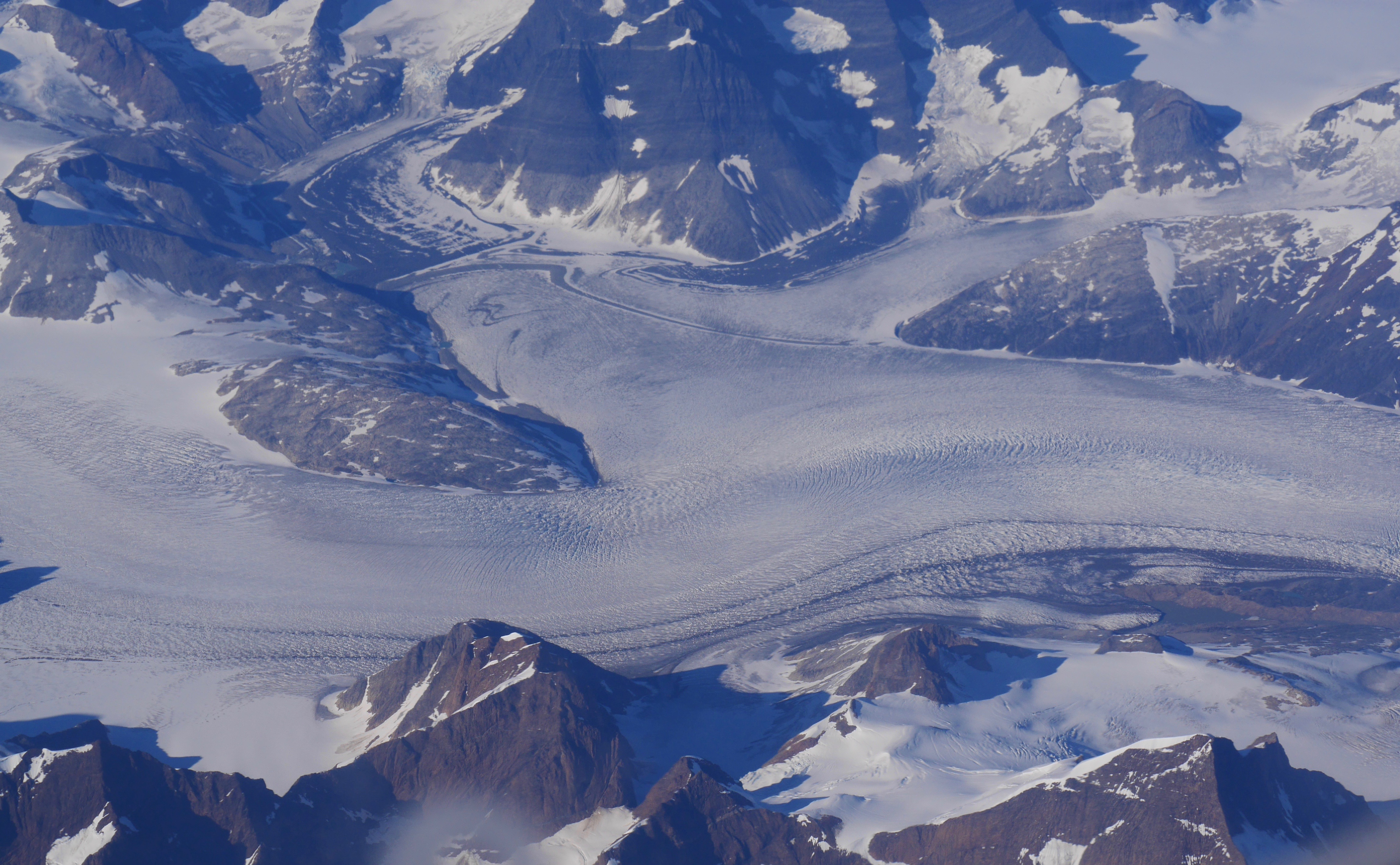
On arrival at Denver airport a poster advertising the Extreme Ice Survey spans the end of the walkway to arrivals. The EIS demonstrates the effectiveness of collaborative arts, humanities and STEM research, its creative use of photography giving a “visual voice” (EIS website) to ecosystems affected by climate change. It’s probably fair to say that most people know about the EIS through the documentary film Chasing Ice, directed by Jeff Orlowski and featuring James Balog. Balog and the EIS – which hefounded – are based at Boulder, Colorado, just a short drive into the Rocky Mountains from Denver. It seems appropriate that someone living in a state considerably shaped by glacial activity, but where the remaining 14 glaciers are approaching the end of their existence (see the “Glaciers of Colorado” at the Glaciers of the American West website of the Departments of Geology and Geography, Portland State University) would become fascinated by ice. I was teaching a seminar recently on John Muir’s Travels in Alaska, for my Literature and the Environmental Imagination module at the University of Essex, and thought of James Balog when we read Muir’s account of a Presbyterian missionary in Alaska who had fallen and dislocated both shoulders. The injured man was helpless and in agony in a very dangerous environment. His concentration had been so directed towards spiritually converting native Alaskans to Christianity that he’d put himself at physical risk. Understanding the environment around him had not seemed so important. Muir, who saved the man’s life, wrote:
I marched him slowly down in the starlight on the comparatively smooth, unassured surface of the little glacier to the terminal moraine, a distance of perhaps a mile, crossed the moraine, bathed his head at one of the outlet streams, and after many rests reached a dry place and made a brush fire. I then went ahead looking for an open way through the bushes to where larger wood could be had, made a good lasting fire of resiny silver-fir roots, and a leafy bed beside it. I now told him I would run down the mountain, hasten back with help from the boat, and carry him down in comfort. But he would not hear of my leaving him.
“No, no,” he said, “I can walk down. Don’t leave me.”
(John Muir,”The Stickeen River,” Travels in Alaska, 1915.)
The episode is from Muir’s 1879 first journey to Alaska, during which he hoped to prove his theory that the American West was shaped by glacial erosion as well as by seismic activity.
Anyone who’s watched the EIS film knows that while there’s no attention to shoulders, James Balog ruined his knees chasing ice. His passion, like that of Muir’s missionary, was persuading people to believe in something – in his case, that the planet’s glaciers are losing their ice much faster than previously expected and that we have to act now if we’re to stand any chance of saving them. Projects to understand what is happening not only above, but inside and under melting glaciers are now raising awareness of the complexity of different areas and types of melt and their effects. NASA’s Global Climate Change web page compares photos of Muir Glacier in Alaska – named after John Muir – in August 1941 and 63 years later in August 2004. I’m curious whether readers who clicked on the above link found themselves having to look twice at the second photo even to see the glacier, as I did. Looking down at Greenland on 31 August 2016 from 36000 feet, the amount of visible rock seemed unnerving in direct proportion to the beauty of the sight.

John Muir’s first published essay, for Horace Greeley’s New-York Tribune newspaper on 5 December 1871, was titled “Yosemite Glaciers.” It gave the public an explanation of the power of ice, in a vocabulary that veers between the aesthetics of the sublime, science and theology. Two glaciers remain in Yosemite National Park, which Muir was instrumental in founding. The palpable sense of wonder in his essay is typical of his manner of writing:
Glaciers work apart from men, exerting their tremendous energies in silence and darkness, outspread, spirit-like, brooding above predestined rocks unknown to light, unborn, working on unwearied through unmeasured times, unhalting as the stars, until at length, their creations complete, their mountains brought forth, homes made for the meadows and the lakes, and fields for waiting forests, earnest, calm as when they came as crystals from the sky, they depart [. . .] . The great valley itself, together with all its domes and walls, was brought forth and fashioned by a grand combination of glaciers, acting in certain directions against granite of peculiar physical structure. All of the rocks and mountains and lakes and meadows of the whole upper Merced basin received their specific forms and carvings almost entirely from this same agency of ice.
Section subtitled “Glacier History,” in “Yosemite Glaciers,” New York Tribune, December 5, 1871.
I’m interested that Muir talks here explicitly about an “agency of ice” that operates “apart from men” to exert its force on something much older that us – the rock that it erodes – while conveying as strong a sense of its affective agency on the human imagination. The conflict of forces that he describes, moreover, can be interpreted as evidence of an elemental ascendency: ice triumphs over fire, for granite is an igneous rock.
As botanist as well as geologist, Muir was at least as interested in moraine as in the ice that produces it. He thrilled to comparative studies of plants that grow on the sediment left by glaciers, always looking, as Alexander von Humboldt had in South America before him, for species that evidence connection more than for those that indicate separateness. Such a comparative framework for enquiry makes Muir and Humboldt global ecologists. Each developed Johann Gottfried Herder’s argument that humans exist within a “natural system” or “geographical aerology” in which all living things in a region respond to the quality and combination of the land, air, water and other local factors, which in turn contribute to a diverse universe of interrelated environments in which beauty equates with variety (Herder, Outlines of a Philosophy of the History of Man, 1791). John Muir’s Alaska is vibrant with ice and life, and so is beautiful.
Ice also haunts. The epigraph that begins this post is from “A Marshland Elegy,” an essay in which conservationist, ecologist and initiator of the term “land ethic,” Aldo Leopold imagines the ghost of a glacier rolling into a localised area of Wisconsin. Leopold was writing about the marsh near to his own small farm, close to Baraboo in Sauk County, one of the Sand Counties (for more on ecology in the Sand Counties see “Central Sand Plains Ecological Landscape,” Wisconsin Department of Natural resources). His shack and 264 acres of land are now a National Historic Landmark. The most obvious focus of “A Marshland Elegy” is the flocks of migrating sandhill cranes that move northward in summer to nest and feed (see my previous post Seeing beyond the Sandhill Cranes). However, the spectacle of the birds becomes a means of addressing long term geological and more rapid ecological change. Their calls, which Leopold likens musically to bells, horns and trumpets – each of which can also suggest an alarm system – become the voice of a biotic community that echoes across epochs. His comparison of the migratory canes with rooted pasque-flowers (prairie smoke, cut-leaved anemone, pulsatilla nuttalliana or anemone patens) anticipates an onwardly haunted future:
“The Cranes do not question the intent of glaciers, emperors of pioneers . . . they trumpeted a warning and sailed across the marsh to another farm.”
“I am reminded . . . every April when the pasque-flowers bloom on every gravelly ridge. Pasques do not say much, but I infer that their preference harks back to the glacier that put the gravel there.”
Aldo Leopold, “A Marshland Elegy,” from A Sand County Almanac: With Other Essays . . . (1949).
Leopold’s deep historical account of the cranes’ habitat describes how “the glacier came down out of the north, crushing hills and gouging valleys.” Lobes of the same pan-North American Laurentide Ice Sheet created the basins for the Great Lakes. Glaciologists and geologists have concluded that the great glacier of the Wisconsin Glaciation, the last great cycle of climate cooling and glacial expansion in North America that took place between 100,000 – 11,000 years ago, extended into Wisconsin around 31,500 years ago. Currently, paleoclimatologists are using computer modelling to increase understanding of atmospheric changes accompanying the “several massive surges of icebergs into the North Atlantic Ocean” in the Heinrich event that 11,ooo years ago – the same time as the final retreat of the glacier from Wisconsin – signified “the irreversible collapse of the Laurentide Ice Sheet” ( See Paleoclimate over the Laurentide Ice sheet at the Last Glacial Maximum, Polar Meteorology Goup, Byrd Polar Centre at Ohio State University and University of Maine Climate Change Institute).
Wisconsin’s post-glacial tundra gradually warmed to become swampland and a fertile, forested moraine. “A Marshland Elegy” contrasts the Eocene origins and persistence of cranes that have lived in that environment with the fast paced violence of humans over the most recent two hundred years. English pioneers arriving in covered wagons “chopped clearing in the timbered moraines that bordered the marsh, and in them planted corn and buckwheat.” By time of Leopold’s purchase of land in 1935 and the beginning of his experiment in restoration, today’s National Park Service, while stressing the current high level of biological diversity, writes
Wheat and corn, staple crops in Wisconsin, stripped vital nutrients from the soil, leading eventually to repeated crop failures. The combination of aggressive agricultural practices, overgrazing of livestock, and severe drought, left the landscape barren. Along with vanishing vegetation, area wildlife suffered great losses. Many indigenous animals either deserted the region to find refuge or perished owing to the depleted environment.
National Historic Landmark Registration Form 10-900, “Aldo Leopold Shack and Farm.”
On the matter of parks, while on this research trip I took a few days to go camping and hiking in Grand Teton National Park, where a ranger, Josh, explained the basic principles underpinning the geology of the area. The Teton region is the product of glacial erosion but also of seismic activity and, as Professor Carol Frost from the University of Wyoming and her colleagues showed in a paper published earlier this year, it reveals the collision of continental tectonic plates similar in action to those that produced the Himalayas. The moraine left by glaciers from the last ice age is visible from the mountains, through its legacy of fertile sedimentary soil around the lakes and onto the plains. While it’s so obviously basic “rock science,” it still amazes me that sedimentary rocks are at the tops of the mountains. And that’s more or less where the remaining Teton glaciers continue grinding away at the rocky surface. Like other parks in the Rocky Mountain West, Teton has some thinning glaciers. I saw only one. It seemed Titanic, like a fallen giant in its mountain den:
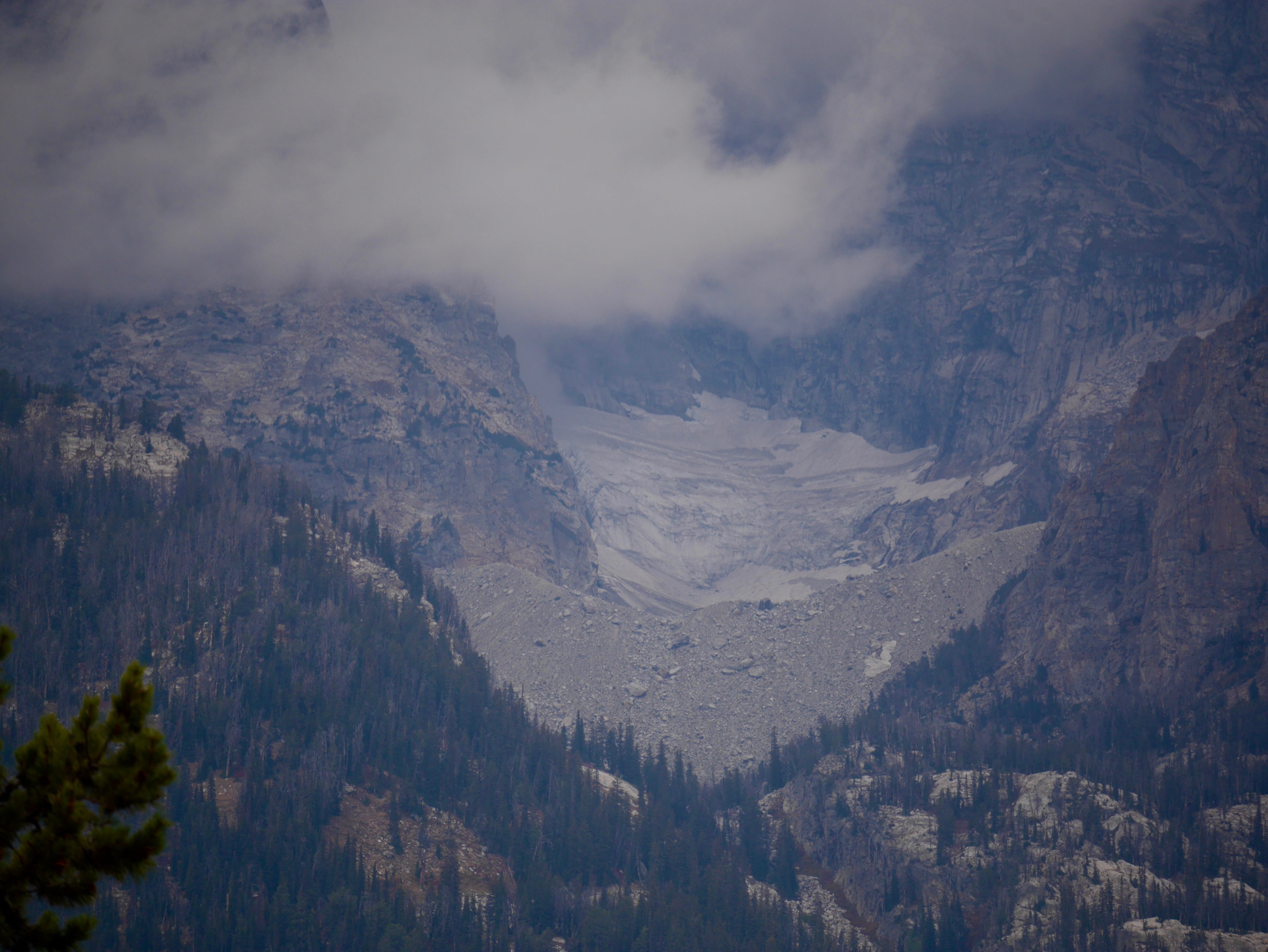

An information board shows the acceleration of its retreat:

As the tourist information board points out, Teton Glacier isn’t all that old: 200 to 600 years at most. Indeed, it dates from a period when Frost Fairs were held on the River Thames in London. The Thames last froze sufficiently for a Frost Fair to take place in 1814, a year before the end of the Napoleonic Wars, at a time when Jane Austen and Walter Scott were writing novels (Mansfield Park and Waverley were published in 1814), while Lord Byron (The Corsair) and Wordsworth (The Excursion) were writing poetry, and two years before Percy Shelley wrote probably his most famous ice poem, “Mont Blanc.” Shelley’s poem begins with its apostrophe to “The everlasting universe of things” that “Flows through the mind,” a sense of permanence that ought now to be read as a warning about complacency in a twenty-first century of ice melt. (My friend at Leeds University and colleague in environmental humanities, David Higgins, is currently writing about Shelley’s “Mont Blanc,” Romanticism and ruin). Mary Shelley would soon begin Frankenstein, which begins in an Arctic wilderness. Caspar David Friedrich’s The Sea of Ice, based on Edward Parry’s 1819-1820 expedition to find a North-West passage through the Arctic Ocean would be painted less than a decade later in 1823.
Returning to Greenland, the surfaces of glaciers reveal their movement and their melting condition. The texture of ice represents another readable script:

A comparison of my photo above with one titled “Ice drainage from the western Antarctic Peninsula onto the northern George VI Ice Shelf,” taken on 14th October by the Antarctic IceBridge team, demonstrates how the visible surface of ice reveals the overall polar nature of the problem of ice melt in ways that suggest both narrative and lyric. I’m trained as a specialist in Romantic literature and am thinking that these photos, with their visual language cutting across linguistic barriers, work like new lyrical ballads for a twenty-first century in which climate change is the biggest cause for global concern.
(Note: The original, experimental poems in Lyrical Ballads, written and published in 1798 by William Wordsworth and Samuel Taylor Coleridge, incisively addressed threats to rural life as well as matters of universal human concern. Only two of the poems – Coleridge’s “Rime of the Ancient Mariner” and Wordsworth’s “Complaint of a Forsaken Indian Woman” – refer to polar ice, but the force of the collection’s stories in combination with deeply philosophical thought about ethical behaviour and the land resonates into our own age of livelihoods endangered by global climate change.)
Henry David Thoreau, American transcendentalist and environmentalist, also thought about ice. Walden (1854), Thoreau’s narrative of his experiment in living well, tells how a study of Walden pond in winter raises matters of philosophical, aesthetic and material concern. His disturbing account of harvesting Walden pond’s ice reads as much like the butchering of an animal as it does the reaping of a crop, with blocks being “raised by grappling irons and block and tackle, and worked by horses, on to a stack [ . . .] in a good day they could get out a thousand tons, which was the yield of about one acre” (Walden, Chapter 16 :”The Pond in Winter). While Thoreau points out that less than 25% of the ice would reach its final destination, he also knew that Boston’s Ice King, Frederic Tudor (1783-1864) made a fortune selling ice from Walden and other ponds locally, to the Caribbean and to Europe. Ice was big business.
Looking back on my last photograph above, the texture of ice interested Thoreau when he used comparative language to convey a sense of aesthetic beauty and spiritual transcendence in an organic natural world beyond the human: “Ice has its grain as well as wood, and when a cake begins to rot or ‘comb,’ [it assumes] the appearance of honeycomb. Thoreau goes on to point out that the frozen structure of ice appears to have developed in sympathetic dialogue with herbaceous plants, for “Even ice begins with delicate crystal leaves, as if it had flowed into moulds which the fronds of waterplants have impressed on the watery mirror” (Walden, Chapter 17, “Spring”).
Returning to melt and climate change, even Thoreau’s chapter title “House-Warming” has become prophetic in ways that Thoreau probably couldn’t have anticipated. Here is his account of the effects of thawing on the pond’s ice. The simile of silver coins draws attention to the commodified status of ice, while the references to the incendiary properties of magnifying glasses and to sounds resembling guns amplify a sense of violence:
As the last two days had been very warm, like an Indian summer, the ice was not now transparent, showing the dark green color of the water, and the bottom, but opaque and whitish or gray, and though twice as thick was hardly stronger than before, for the air bubbles had greatly expanded under this heat and run together, and lost their regularity; they were no longer one directly over another, but often like silvery coins poured from a bag, one overlapping another, or in thin flakes, as if occupying slight cleavages. The beauty of the ice was gone, and it was too late to study the bottom. Being curious to know what position my great bubbles occupied with regard to the new ice, I broke out a cake containing a middling sized one, and turned it bottom upward. The new ice had formed around and under the bubble, so that it was included between the two ices. It was wholly in the lower ice, but close against the upper, and was flattish, or perhaps slightly lenticular, with a rounded edge, a quarter of an inch deep by four inches in diameter; and I was surprised to find that directly under the bubble the ice was melted with great regularity in the form of a saucer reversed, to the height of five eighths of an inch in the middle, leaving a thin partition there between the water and the bubble, hardly an eighth of an inch thick; and in many places the small bubbles in this partition had burst out downward, and probably there was no ice at all under the largest bubbles, which were a foot in diameter. I inferred that the infinite number of minute bubbles which I had first seen against the under surface of the ice were now frozen in likewise, and that each, in its degree, had operated like a burning-glass on the ice beneath to melt and rot it. These are the little air-guns which contribute to make the ice crack and whoop.
From Walden, Chapter 13, “House-Warming.”Taken here from The Thoreau Reader, a project in cooperation with The Thoreau Society.
On the matter of thinning ice, he describes an experiment at Harvard that again draws attention to the effect of thawing in magnifying solar rays:
I have been told that in the experiment at Cambridge to freeze water in a shallow wooden pond, though the cold air circulated underneath, and so had access to both sides, the reflection of the sun from the bottom more than counterbalanced this advantage. When a warm rain in the middle of the winter melts off the snow-ice from Walden, and leaves a hard dark or transparent ice on the middle, there will be a strip of rotten though thicker white ice, a rod or more wide, about the shores, created by this reflected heat. Also, as I have said, the bubbles themselves within the ice operate as burning-glasses to melt the ice beneath.
From Walden, Chapter 17, “Spring.“
Meanwhile the percussive song of the ice draws attention to its vulnerability:
The cracking and booming of the ice indicate a change of temperature. One pleasant morning after a cold night, February 24th, 1850, having gone to Flint’s Pond to spend the day, I noticed with surprise, that when I struck the ice with the head of my axe, it resounded like a gong for many rods around, or as if I had struck on a tight drum-head. The pond began to boom about an hour after sunrise, when it felt the influence of the sun’s rays slanted upon it from over the hills; it stretched itself and yawned like a waking man with a gradually increasing tumult, which was kept up three or four hours. [. . .] The fishermen say that the “thundering of the pond” scares the fishes and prevents their biting. The pond does not thunder every evening, and I cannot tell surely when to expect its thundering; but though I may perceive no difference in the weather, it does. Who would have suspected so large and cold and thick-skinned a thing to be so sensitive?
From Walden, Chapter 17, “Spring.“
Thoreau’s writing needs to be understood as being of its time, and its undeniably Romantic as well as including an informed lay understanding of science. But he surely has a lot to say to us now.
Returning to the twenty-first century, I’d like approach a conclusion by means of some final considerations and some more images from my journey over Greenland. This post began with those views. I’ve commented on reports of the struggle for life faced by polar bears having to adapt to shorter Arctic winters and smaller ice floes. The University of Delaware and some other institutions are working with NASA’s Project IceBridge on a study that is a predicting a restriction in the habitat and a likely decline in the population of Adélie penguins, due to shifting temperatures and ice melt. That study points out that Adélie Penguins have for millions of years responded to changes in glaciation: “the geologic record tells us that as glaciers expanded and covered Adélie breeding habitats with ice, penguins in the region abandoned their colonies. When the glaciers melted during warming periods, the Adélie penguins were able to return to their rocky breeding grounds” (see “Climate Change May Shrink Adélie Penguin Range By End of Century“). The investigation views the current situation as potentially different, however: “this warming may no longer be beneficial for Adélie penguins. In a paper published June 29 in the journal Scientific Reports, the researchers project that approximately 30 percent of current Adélie colonies may be in decline by 2060, and approximately 60 percent of the present population might be dwindling by 2099.” Polar Bears and penguins are charismatic megafauna, as well as being sentinel or indicator species. They are large, powerful or appealing enough for their vulnerability to elicit an emotive public call for action. It’s probably fair to say that they’re inseparable from our idea of what the Arctic and Antarctic are. What of creatures that are less visible?
While at the University of Wyoming, I was privileged to see the Art Museum’s astonishing retrospective “Waste Land: A Survey of Works by Brandon Ballengée, 1996-2016.” The exhibition was extremely moving. Ballengée is a marine biologist and artist who works on mutation and deformity due to habitat change, with specific attention to changes brought about by pollution. Some of his works address experimentation. I’ll say more about that exhibition in my next blogpost, because it wasn’t really concerned with ice. But one exhibit, Ballengée’s film Requiem pour Flocons de neige Blessés (A Requiem for Injured Snowflakes), includes a delicate icy metaphor just as it explores the transience of melting things. Made in scientific collaboration with David M. Green of McGill University and Stanley K. Sessions, and with a haunting minimalist musical score by Ariel Benjamin and Andrew Diluvian, the film uses a series of 21 photographs of tiny, malformed toad tadpoles from southern Quebec. The toads could not develop to maturity because of deformities due to a range of possibly interrelated causes: the exhibition’s caption to the film says that “each toad was born into a hostile universe of predators, parasites and environmental degradation.” The exhibition notice to Requiem pour Flocons de neige Blessés ends with a dedication: “This finite / infinite artwork is a memorial to all these small creatures and in honor of the countless number of beings that have come into this world and passed without notice.”
That the complex ecologies of Greenland’s glacial environment and the surrounding Arctic Ocean consist of tiny and short-lived creatures as well as polar bears, walruses, whales and seals is obvious and well-known. But scientists still don’t know exactly how food chains and species will be affected as the glaciers and sea-ice melt. The photos used here capture beauty and uncertainty. I hope they link ice and thought. They’re less abstract in appearance than those in Ice Thoughts, where the aim was to let the images speak more for themselves. I’ve tried here to follow that earlier post by developing more extensive narrative enquiries as well as lyrical meditations about ice.
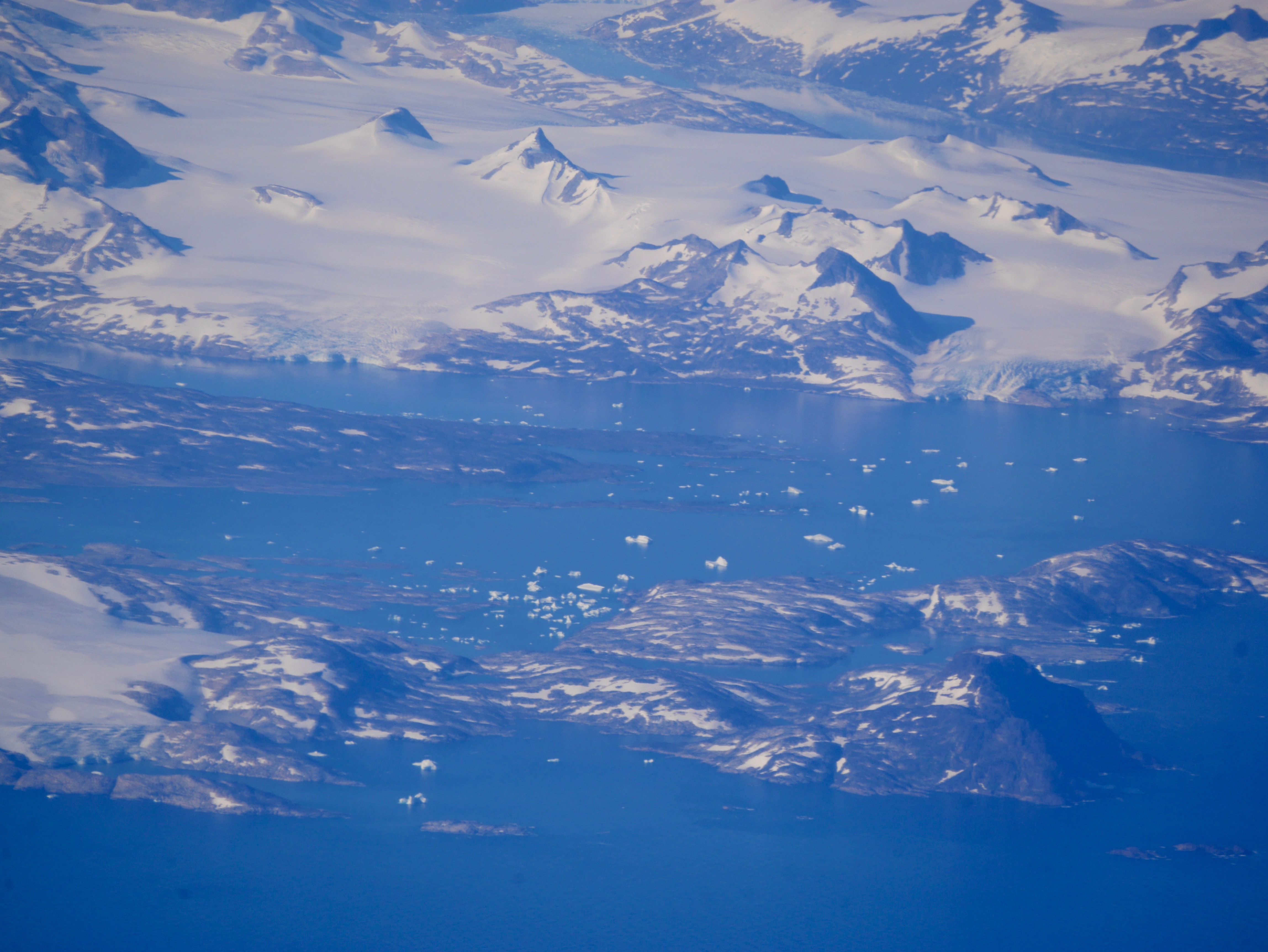
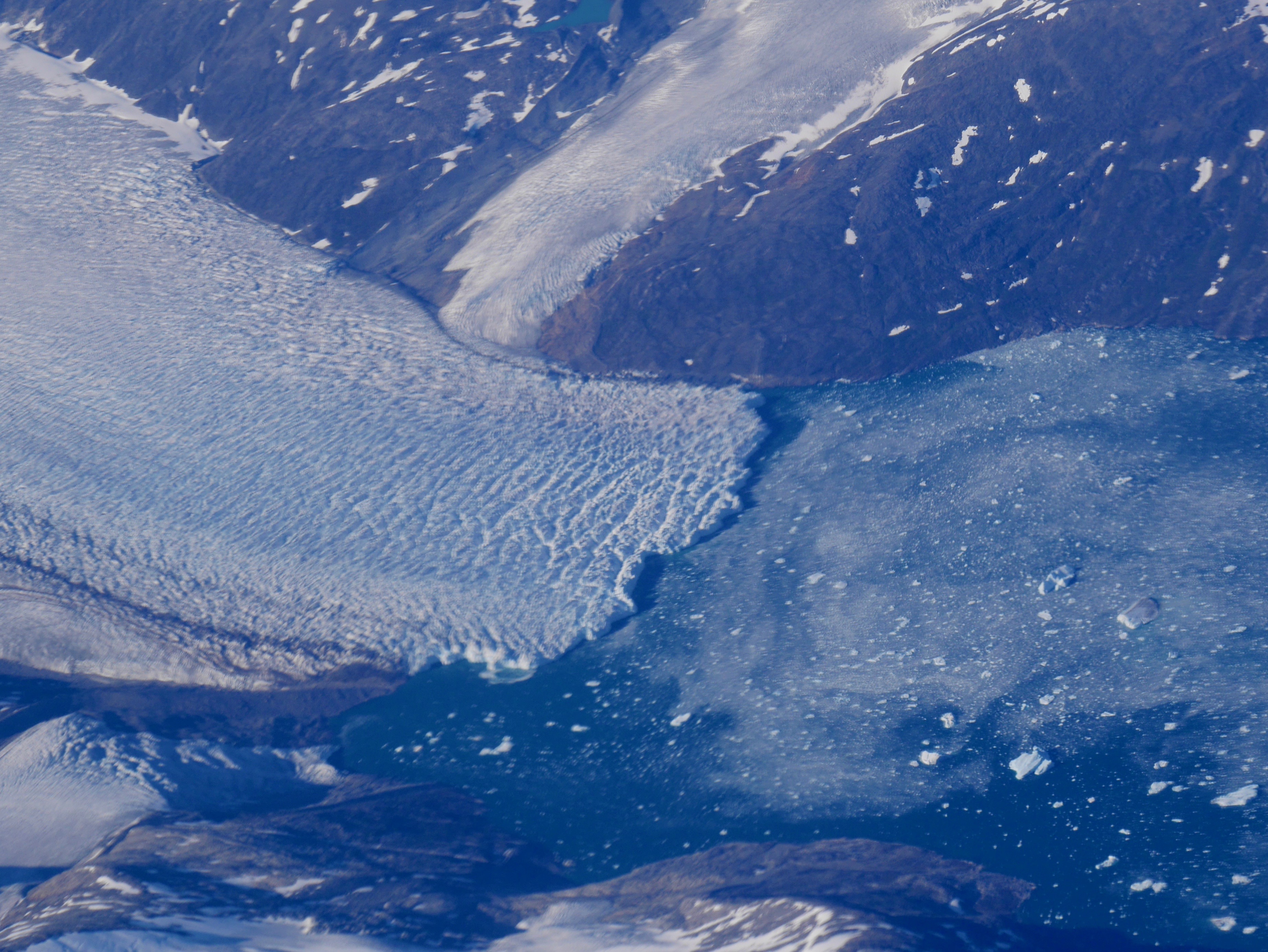
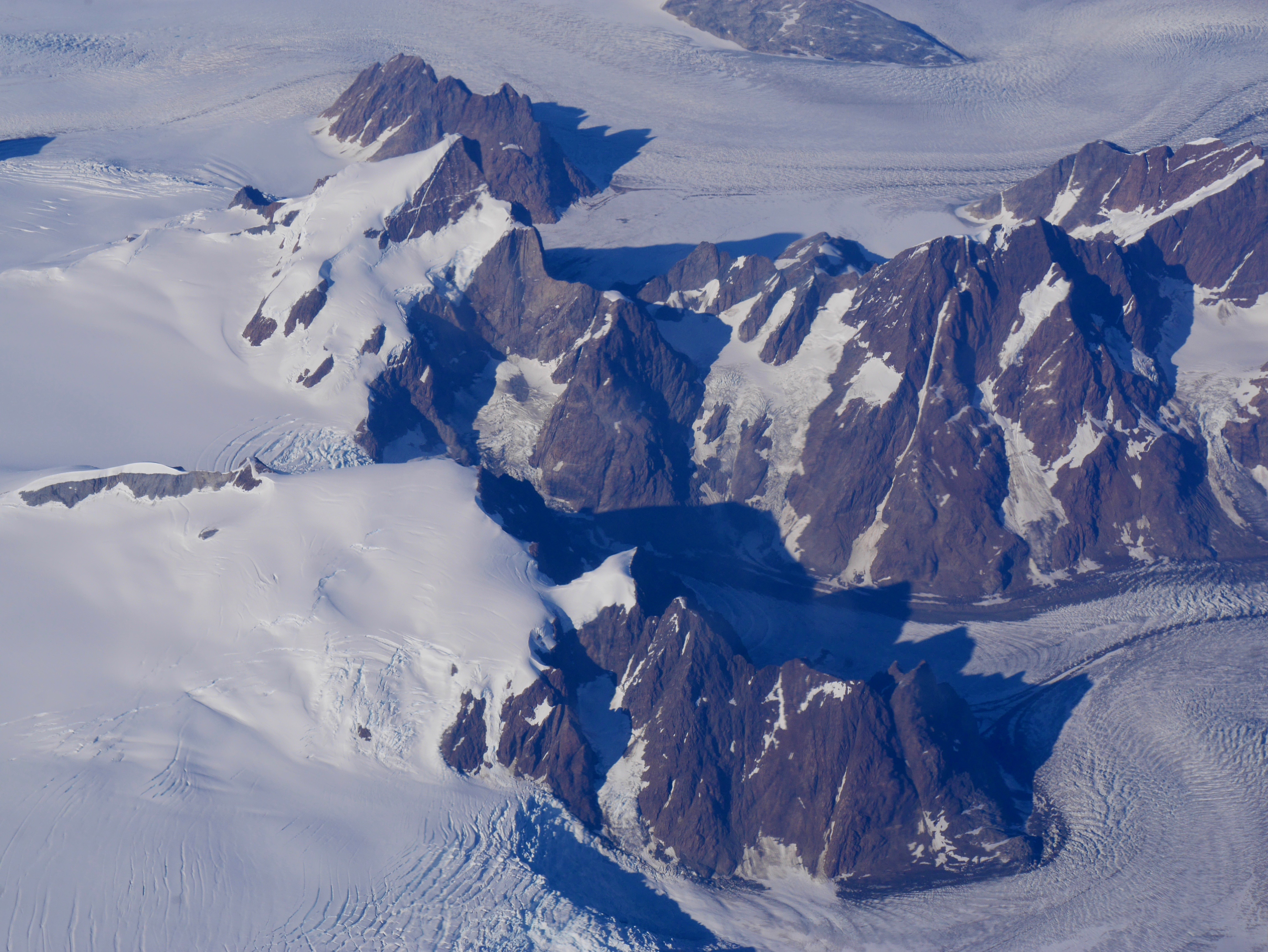
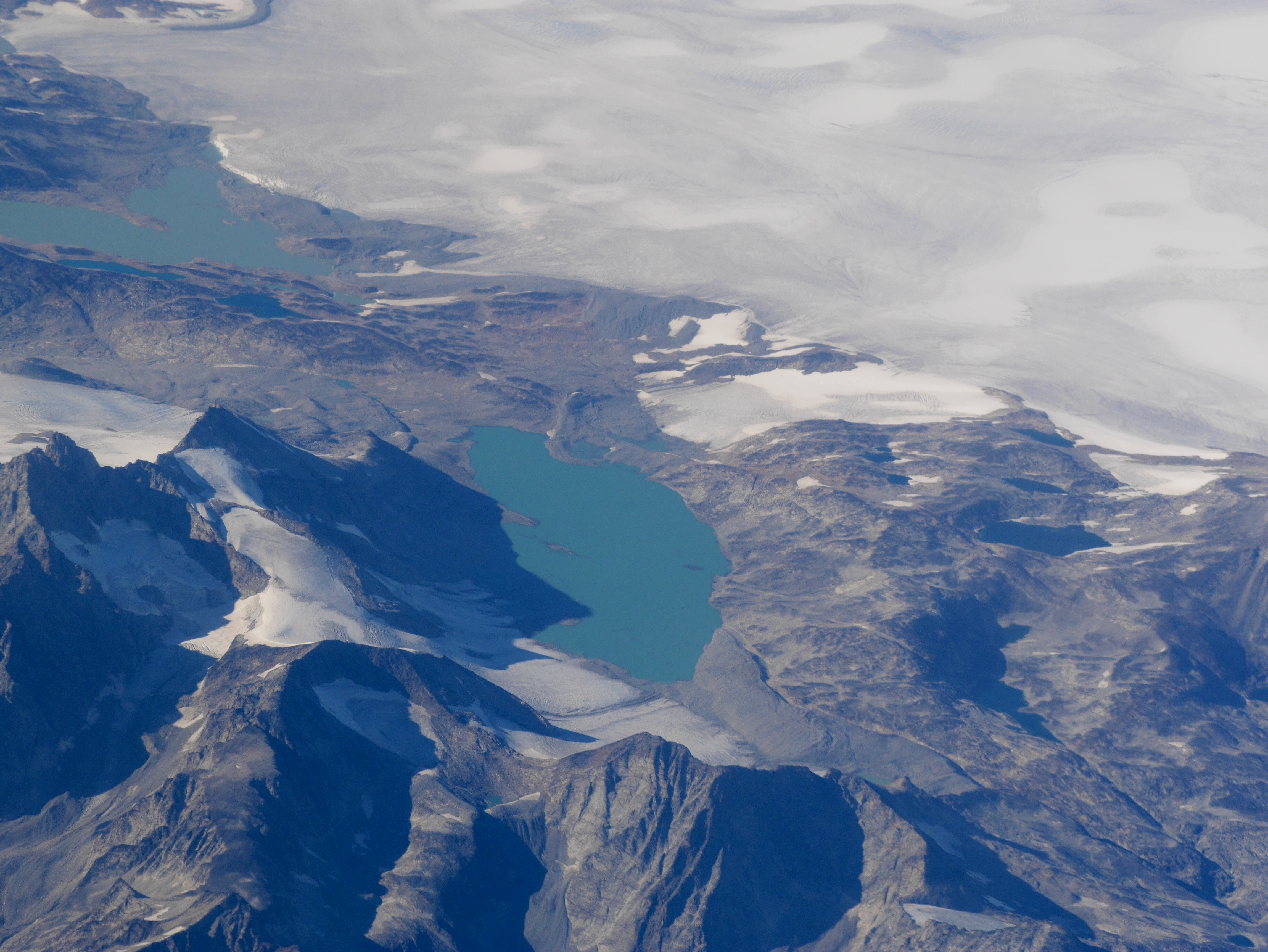
PLANTS AND ANTIBIOTICS

Rabbitbrush. (My photograph)
The article below about the antiseptic and antibiotic properties of plants is from the New York Times Magazine. I decided to post it because, as you know from my writing, I’m deeply interested in the relationship between plants and people. The crisis of antibiotic resistant infection is one that stares us in the face. We share the world with these mostly quiet living beings. They contribute materially, but also aesthetically, culturally and spiritually to out busy lives.
I visited some good friends last week. They took advice about wildflowers native to their area and sowed their front lawn with yellow coneflowers – the purple coneflower, Echinacea purpurea being the source of the echinacea supplement that we buy to protect against colds. The idea was initially to save water, given that coneflowers survive in the wild in their arid state. Someone complained that they were encouraging weeds and suggested they tidy their yard. People plant coneflowers in gardens all of the time, so I think the problem of perception in this case arose because they were seeded randomly in the lawn. In other words, they had exceeded the boundaries imposed by “normal” gardening. Another friend remembers being asked why she had planted a line of tansy alongside her garden wall. Tansy, Tanecetum vulgar, was brought to North America in the 1620s by European settlers because it has medical benefits and some culinary uses, although it is also toxic if not used carefully. Like the Silphium laciniatum, cut-leaf silphium or compass plant which features regularly in my posts, and about which Aldo Leopold so movingly wrote in A Sand County Almanac, it’s the commonplace plants that are easily dismissed.
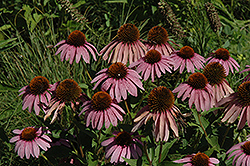
Echinacea purpurea or purple coneflower. (Photograph from NetPS Plant Finder)

Tanecetum vulgar or tansy. (Photograph Montana Weed Control Association)
Like many other people, I love sagebrush and rabbit brush, plants of the prairie. The pungent scent of sagebrush after rain is thrilling. It’s a variety of artemisia, a plant used in the perfume industry – big sagebrush is also named Artemisia tridentata. Sagebrush has long been known by indigenous communities to have potent medicinal and spiritual healing qualities. Nevada recognises big sagebrush as its State Flower. Rabbitbrush, a species of Chrysothamus, likewise has medicinal qualities that are physical and spiritual. It’s sometimes classified as an invasive weed because of its vigorous growth in marginal soils. But the vitality and hardiness of rabbitbrush mean that it is one of the first plants to regrow in prairies areas ravaged by wildfires (I’m grateful to Utah State University’s pro-rabbitbrush Invasive Weeds Website for this information). The roots are help to prevent soil erosion.
So this introduction to the essay below is also a tribute to the coneflower, tansy, sagebrush, rabbitbrush and other delectable weeds

Big sagebrush and cottonwoods near Jackson, Wyoming. Cottonwoods are weed trees and the State Tree for Wyoming (plains cottonwood, Populous deltoids, sub species monilefera), Kansas and Nebraska (eastern cottonwood, Populous deltoides).
(My photograph).
My next post will likely be about grasses.
Here’s the New York Times article: